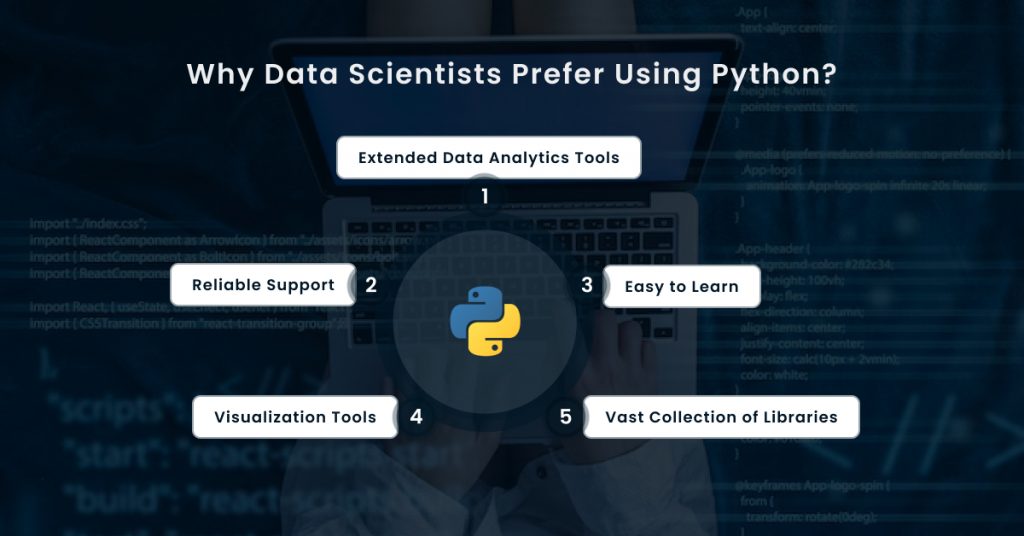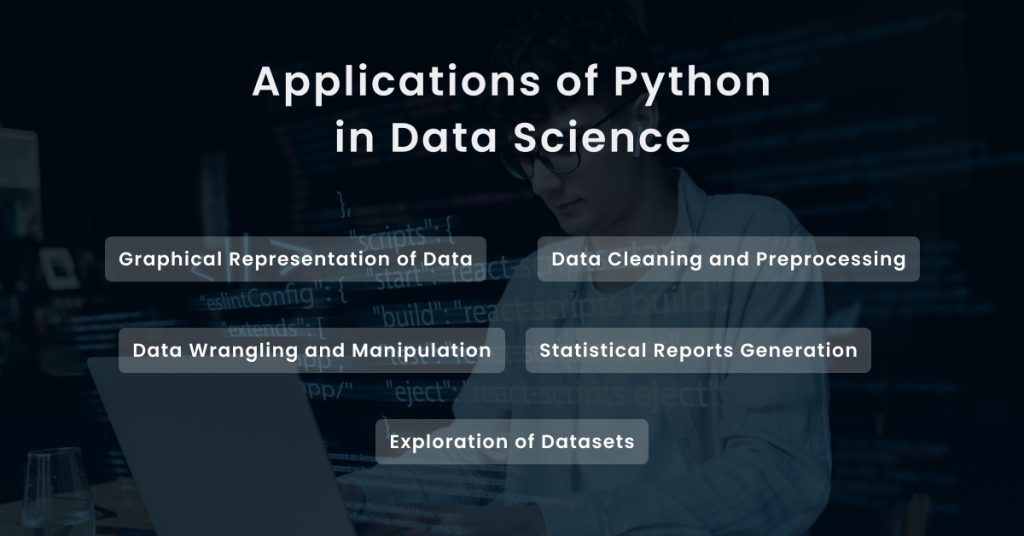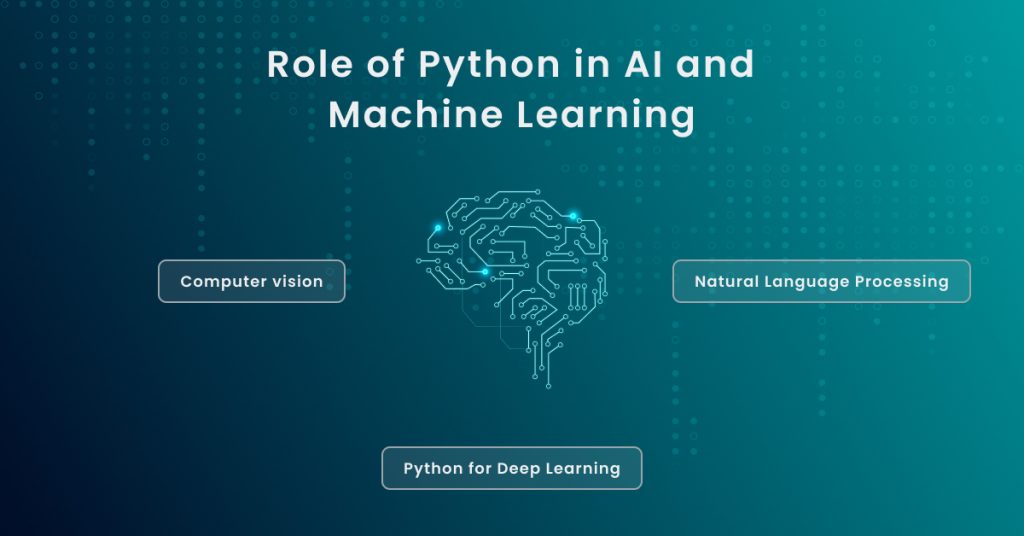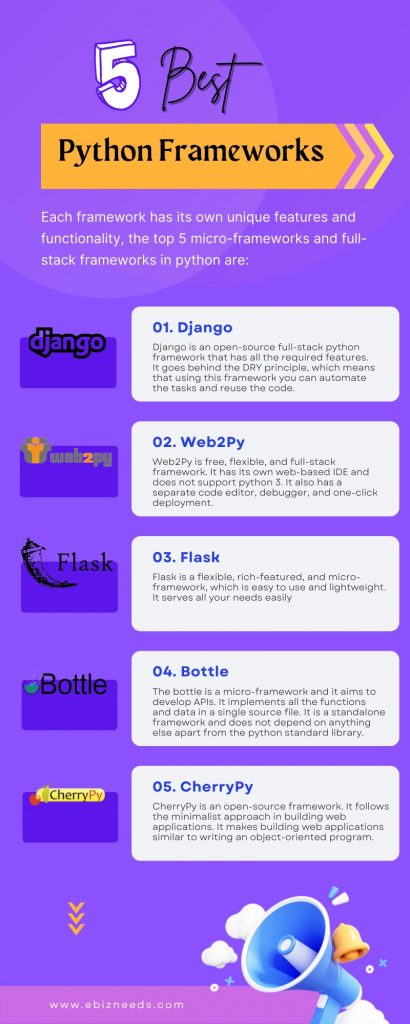In today’s technological world, there is an emerging adage “Data is the new oil” as data is playing an important role in streamlining our day-to-day lives. That’s why there has been a huge demand for data scientists. As a result, a lot of IT professionals are looking to learn the skills necessary to become data scientists.
Data sciences involves finding valuable insights from the data. The data scientists employ a lot of techniques to extract the required insights. The techniques could be of mathematics, statistics, computer science, or machine learning. But implementation of these techniques to work with digital data requires programming and here comes the role of the most popular programming language for data science “Python”.
Python has been the most popular programming language to learn and implement data science. It is a versatile language which makes it a good fit to perform different types of tasks like data wrangling, data visualization, machine learning, deep learning, and others. It is also an easy-to-learn programming language. The syntax isn’t too much complicated and that’s why many newbies also prefer to learn Python first. Furthermore, it is being used in the production environments of IT mammoths like Google and Facebook.
But is it all that makes Python perfect for data science? Certainly No! Many other capabilities of Python make it a preferred choice for data scientists. In this article, we will go through various aspects of Python in data science, and what makes it so popular for data science. But first, let’s know what is Python.
A Brief Overview of Python:
Released in 1991, Python is a general-purpose programming language that supports OOPS (Object-Oriented), Structured, and Functional programming paradigms. People mostly get baffled by its reptile species name however, it is named after a famous British comedy troupe Monty Python’s Flying Circus.
Currently, it is amongst the top five most used programming languages and competes with languages like JavaScript, HTML/CSS, SQL, and Typescript. Then why among these five different languages, does Python hold the most value for data science? You will get the answer in this article. The reasons why it is used so predominantly in data science are the same as why you should learn this language.
Why Data Scientists Prefer Using Python?



Python is a highly cross-functional programming language which offers multiple benefits to programmers. With Python, it becomes easier for the data scientists to understand the highly complicated data sets.
Another major advantage of using Python is its easy readability. The other analysts or data scientists can also collaborate on the projects. It is also easy to maintain if required to adapt to new data sources. Here are the major factors that make Python a data-friendly language:
a. Easy to Learn:
The syntax and readability of Python are so simple that even beginners in programming can understand it. The data scientists have to spend very little time to familiarize themselves with the overall program written in Python.
An easy learning curve of this language sets it apart from the old programming languages with complicated syntax. For instance, in languages such as Java, C+, Ruby, and others; the learning curve is steep so beginner programmers can’t easily comprehend the language. On the other hand, Python programs are quite simple to understand which allows data analysts to perform various data-related tasks simultaneously.
b. Vast Collection of Libraries:
There is an extensive collection of free libraries in Python for its users. Also, these libraries grow consistently to deliver powerful solutions. These libraries come with powerful tools for data analysis, visualization, machine learning, and deep learning. Here are some of the most popular Python libraries:
· Numpy:
Numpy library is used to perform scientific computing. It comes with a multidimensional array object along with the required tools and functions of mathematical operations to work with these operations.
· Pandas:
This library is extensively used for data manipulation and analysis. It comes with several tools to read and write data in different formats such as CSV, Excel, and SQL formats. There are many tools available for data exploration, cleaning, and preparation.
· SciPy:
This library is also used for scientific computing and provides tools for operations like integration, interpolation, optimization, linear algebra, etc.
· Matplotlib:
This library serves the purpose of data visualization in Python. There are a plethora of tools for data visualization such as line charts, scatter plots, bar charts, histograms, etc.
· Sckit-learn:
This library is focused on machine learning in Python. There are tools for data preprocessing, feature selection, model selection, and evaluation. It also has a huge range of ML algorithms like linear regression, logistic regression, vector machine support, decision trees, etc.



c. Reliable Support:
Although Python is a simple programming language, still there will be situations during which you will require a helping hand with the programming language. Fortunately, there is a collection of libraries which have helpful support material. They are completely free of cost.
Apart from this, you can use user-contributed codes from mailing lists to documentation, and much more. Even more, the users can reach out to other programmers situated anywhere on earth to ask for help and suggestions whenever required.
d. Visualization Tools:
It is easier to understand the visuals than the text. Thus, the visualization tools hold a great importance in the Python language. They can provide meaningful insights in the form of graphs, charts, or graphics for easy understanding. Also, you are not required to be an expert in data visualization.
The data presentation and visualization matter a lot while showcasing the data to all the involved stakeholders. A better representation gives a better understanding to the stakeholders so they can identify the right trends and make the strategies accordingly.
e. Extended Data Analytics Tools:
Although it is essential to collect data for data analysis, the extracted data should also be handled effectively. In Python, there are a lot of built-in tools which will help you identify patterns and spot the right information for better insights.
Read also: 17 Best Python Frameworks for Web Development in 2024
Applications of Python in Data Science:



Python has five major applications in data science:
a. Exploration of Datasets:
A major step in data analysis is exploring data sets. Python libraries come with tools for reading and writing data in multiple formats and can do data exploration, cleaning, and preparation.
b. Data Cleaning and Preprocessing:
Data cleaning and preprocessing are two major steps in data analysis and in the field of data science. The Pandas library of Python comes with tools of data cleaning, and preprocessing. These tools help in removing duplicates, dealing with missing values, and transforming data accordingly.
c. Data Wrangling and Manipulation:
These are also unavoidable steps in data science. Here the most useful library of Python is NumPy which allows you to work with arrays like indexing, slicing, and reshaping arrays. It also lets you perform mathematical operations on arrays.
d. Statistical Reports Generation:
Statistical report generation is a critical part of the data analysis. You can use the SciPy library of Python for statistical analysis like hypothesis testing, regression analysis, cluster analysis, and others.
e. Graphical Representation of Data:
In data visualization, the graphical representation of data is necessary for presenting data. The Seaborn library of Python comes with multiple tools for creating statistical graphics like heatmaps, pair plots, facet grids, etc. and helps with complex visualizations with multiple variables.
Role of Python in AI and Machine Learning:



Machine learning and AI are now important subfields of computer science and deal with the design and development of algorithms. These algorithms are widely used for prediction, clustering, and classification. Python also plays an important role in various aspects of AI and Machine learning. Let’s know in brief about the role of Python in ML & AI:
a. Python for Deep Learning:
Deep learning employs neural networks to learn features from data. It is used for building deep neural networks and applying deep learning for natural language processing. It can also work with convolutional neural networks.
b. Natural Language Processing:
Python comes with a vast collection of libraries especially built for Natural Language Processing such as NLTK (Natural Language Toolkit), spaCy, Gensim, TextBlob, Transformers, and others. It can perform many tasks of natural language processing like text preprocessing, sentiment analysis, Named Entity Recognition (NER), Text Classification, summarization, and much more.
c. Computer vision:
Python has even libraries for computer vision. The common libraries used by Python for computer vision are OpenCV and TensorFlow.



Read Also: Reasons to Use Python for Front-End Web Development
Wrapping Up:
In this article, we have gone through multiple aspects of Python’s importance for data science. At Ebizneeds, the best IT Development company in India, we are having expertise in developing Python-based apps with advanced features and functionalities. Our team of Python developers are well-versed in developing apps for any industry, use case, or scale. Let us know your requirements.



Naveen Khanna is the CEO of eBizneeds, a company renowned for its bespoke web and mobile app development. By delivering high-end modern solutions all over the globe, Naveen takes pleasure in sharing his rich experiences and views on emerging technological trends. He has worked in many domains, from education, entertainment, banking, manufacturing, healthcare, and real estate, sharing rich experience in delivering innovative solutions.


